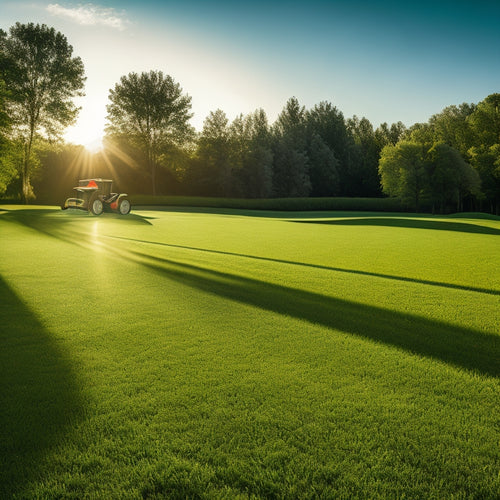
Water-Wise Landscaping: Conserve While Beautifying Your Yard
Share
By incorporating water-wise landscaping strategies into your outdoor space, you can effortlessly conserve this precious resource while still enjoying a lively, thriving yard that exceeds your wildest design dreams. Select drought-tolerant plant species, design efficient irrigation systems, and employ rainwater harvesting strategies to minimize waste. Improve soil health with advanced moisture management, mulching, and groundcovers, and opt for water-saving turf alternatives. As you investigate these innovative techniques, you'll uncover a world of possibilities for creating a stunning, eco-friendly oasis that not only conserves water but also enhances your property's aesthetic appeal and value.
Key Takeaways
- Implement drought-tolerant plant species, native plants, and xeriscaping principles to reduce water consumption and support local ecosystems.
- Design efficient irrigation systems with smart controllers, soil moisture sensors, and drip irrigation to minimize waste and maximize results.
- Manage soil moisture levels with advanced sensors, precision control, and mulch to prevent overwatering and underwatering.
- Utilize rainwater harvesting strategies, such as rain barrels and rooftop collection, to conserve water and reduce water bills.
- Incorporate water-saving turf alternatives, like synthetic turf, native grasses, and ornamental clover, to reduce water consumption and maintenance.
Drought-Tolerant Plant Species Selection
Selecting drought-tolerant plant species is a crucial step in creating a water-wise environment, as it allows you to conserve water while still enjoying a lively and thriving outdoor space.
By incorporating native plant selection, you'll reduce water consumption and support local ecosystems. Adopt xeriscaping principles, which prioritize efficient water use, and implement seasonal planting strategies to guarantee your garden thrives year-round.
Choose pollinator-friendly options, like colorful succulents and aromatic herbs, to attract beneficial insects.
When designing your solar-powered irrigation system, consider optimizing your solar panel array to maximize energy production and reduce waste. Additionally, selecting energy-efficient equipment can help minimize losses and reduce operating costs.
Experiment with diverse foliage textures and companion planting to create visually appealing combinations.
Don't forget to include drought-resistant trees and edible gardens to enhance your yard's functionality.
Efficient Irrigation System Design
As you design your irrigation system, you'll want to take into account smart controller options that can adjust watering schedules based on real-time weather data.
You'll also want to incorporate soil moisture sensors to guarantee your plants receive the right amount of water, eliminating overwatering and underwatering.
By combining these technologies with drip irrigation, which delivers water directly to the roots, you'll be able to create a highly efficient system that minimizes waste and maximizes results.
Additionally, integrating energy storage systems solar-powered solutions can further reduce your carbon footprint and reliance on traditional power sources, making your water-wise landscaping even more sustainable.
Smart Controller Options
Efficiency converges with innovation in the domain of smart controller options, where sophisticated technology harmonizes with thoughtful design to create an optimized irrigation system.
You'll find smart irrigation technologies that adjust watering schedules based on real-time weather data, ensuring your environment receives the right amount of water.
As Renewable Energy Sources play a crucial role in reducing carbon footprint, smart controllers can also be powered by solar energy, further minimizing environmental impact.
Automated watering systems can be programmed to water during cooler parts of the day, reducing evaporation and runoff.
With smart controllers, you can monitor and control your irrigation system remotely, receiving notifications and alerts to potential issues.
This level of precision and control enables you to make informed decisions, saving water and resources while maintaining a thriving environment.
Soil Moisture Sensors
Dig into the world of precision irrigation with soil moisture sensors, which enhance your game by ensuring your terrain receives the perfect amount of water.
These innovative sensors employ advanced sensor technology to monitor soil moisture levels in real-time, providing you with precise data to optimize your irrigation schedule.
By leveraging moisture monitoring, you can avoid overwatering and underwatering, reducing waste and conserving this precious resource.
As seen in renewable energy solutions, incorporating state-of-the-art technology can greatly reduce energy consumption and support corporate sustainability goals.
With accurate readings, you can adjust your irrigation system to deliver water exactly when and where it's needed, giving your plants the perfect amount of hydration.
This state-of-the-art technology enables you to make informed decisions, freeing you from the guesswork of traditional irrigation methods.
Drip Irrigation Benefits
With your soil moisture sensors in place, you're now ready to optimize your irrigation system design with the precision of drip irrigation. This efficient system delivers water directly to the roots, reducing evaporation and runoff.
By targeting the exact areas that need hydration, you'll conserve a significant amount of water. In fact, drip irrigation can save up to 50% of water compared to traditional sprinkler systems. This water conservation method is especially vital in areas where water restrictions are in place.
As seen in solar roofing systems, reducing our reliance on non-renewable resources is key to a cleaner environment. By utilizing renewable energy sources, we can decrease our carbon footprint and contribute to a more sustainable future.
With drip irrigation, you'll enjoy a beautiful, thriving environment while minimizing your environmental footprint. By making the switch, you'll not only conserve water but also reduce your water bill, giving you the freedom to enjoy your outdoor space without the guilt.
Rainwater Harvesting Strategies
You're likely familiar with the concept of collecting rainwater, but have you considered the various strategies involved in utilizing this essential resource for your landscaping needs?
Rainwater harvesting strategies are crucial for water-wise landscaping. One approach is to implement rain barrel systems, which capture and store rainwater for later use.
Rooftop collection is another effective method, where rainwater is channeled from your roof into a storage tank. This harvested water can then be used for irrigation, toilet flushing, or even washing your car.
Mulch and Groundcover Benefits
As you design your water-wise environment, you're likely considering how to prevent soil erosion, suppress weeds, and retain moisture.
Mulch and groundcovers are essential components in achieving these goals, and by incorporating them into your design, you'll create a resilient and sustainable outdoor space.
Soil Erosion Prevention
Frequently, soil erosion sneaks up on unsuspecting homeowners, causing significant damage to their surroundings. As you design your yard, it's crucial to implement erosion control measures to protect your investment. Mulch and groundcovers are effective solutions for preventing soil erosion. These sustainable practices not only conserve water but also reduce the risk of erosion.
| Erosion Control Method | Benefits |
|---|---|
| Organic Mulch | Reduces soil temperature, increases water retention, and prevents erosion |
| Inorganic Mulch | Provides long-term erosion control, doesn't decompose, and is low maintenance |
| Groundcovers | Stabilizes soil, reduces runoff, and creates a natural, beautiful environment |
| Combination of Mulch and Groundcovers | Offers maximum erosion control, water conservation, and aesthetic appeal |
Weed Suppression Methods
Weed suppression is an essential aspect of water-wise gardening, and mulch and groundcovers play a significant role in preventing unwanted vegetation growth.
You can use organic mulching to suppress weeds naturally, reducing the need for chemical herbicides. Companion planting with native species can also help crowd out invasive species, promoting plant diversity and reducing garden upkeep.
Ground covers like creeping thyme or sedum can fill gaps between pavers, reducing seasonal weeding tasks.
In garden design, consider incorporating natural herbicides like boiling water or vinegar to control weeds.
Moisture Retention Benefits
With mulch and groundcovers in place, your soil's water-holding capacity gets a significant enhancement, allowing you to conserve this precious resource. By implementing these moisture retention techniques, you'll reduce the need for frequent watering and minimize evaporation. This water conservation strategy is especially vital in areas prone to drought or water restrictions.
| Moisture Retention Benefits | Mulch | Groundcovers |
|---|---|---|
| Reduces Evaporation | 30-40% reduction | 20-30% reduction |
| Increases Water Infiltration | 2-3 times more water absorbed | 1.5-2 times more water absorbed |
| Soil Temperature Regulation | 2-5°F cooler in summer, 1-3°F warmer in winter | 1-3°F cooler in summer, 0.5-2°F warmer in winter |
Soil Improvement Techniques
Your soil's structure and fertility play an important role in water-wise gardening, as they directly impact plant health, water absorption, and runoff.
To create an ideal soil environment, you'll want to test your soil's pH levels to determine if it's acidic, alkaline, or neutral. Based on the results, you can adjust the pH by adding lime or sulfur.
Compost application is another vital technique, as it enhances soil structure, increases water-holding capacity, and supports beneficial microbial activity. Apply a 2- to 4-inch layer of compost to your soil, mixing it well to create a nutrient-rich growing medium.
With these soil improvement techniques, you'll be well on your way to creating a thriving, water-efficient garden that requires minimal maintenance and resources.
Gray Water Reuse Methods
A gray water system, comprising a network of pipes and irrigation lines, can considerably reduce potable water consumption in your garden.
You'll need to evaluate treatment options, such as aerobic treatment units or natural systems, to remove contaminants and pathogens. Storage solutions, like tanks and ponds, will also be necessary to hold the gray water until it's used.
Be sure to check local legal regulations regarding gray water reuse, as they vary by region.
When designing your garden, incorporate gray water-friendly plants and irrigation methods, like drip irrigation, to maximize efficiency.
Filtration methods, like sedimentation or biological filters, can further refine the water quality.
Water-Saving Turf Alternatives
Turfgrass, a staple of traditional landscaping, guzzles precious water resources, making it an unsustainable choice for eco-conscious gardeners.
You can break free from this water-intensive habit by exploring water-saving turf alternatives. Consider synthetic turf, a low-maintenance option that mimics the look and feel of natural grass.
Native grasses, like buffalo grass or blue grama, are another eco-friendly choice, requiring less water and maintenance. Ornamental clover is a pet-friendly option that's drought-resistant and shade-tolerant.
When replacing your turf, opt for low-maintenance grass varieties that conserve water and reduce your environmental footprint.
Climate-Specific Landscaping Tips
As you reimagine your outdoor space with water-saving turf alternatives, consider the unique challenges and opportunities presented by your local climate.
In arid regions, focus on native plant advantages like drought tolerance and low water requirements.
In areas with distinct seasons, employ seasonal planting strategies to guarantee year-round interest and minimize maintenance.
For example, plant cool-season grasses in fall or early spring, and warm-season grasses in late spring or early summer.
By embracing your climate's quirks, you'll create a resilient, low-maintenance environment that not only conserves water but also celebrates the natural beauty of your region.
Smart Watering Schedule Management
By integrating a smart watering schedule into your water-wise gardening plan, you'll optimize water distribution, reduce waste, and create a lush, thriving environment.
To do this, you'll need to make seasonal adjustments based on weather patterns, soil type, and plant hydration needs. During hot summer months, increase watering frequency, but decrease duration to prevent evaporation.
In cooler months, reduce frequency and increase duration for deeper plant hydration.
Consider using a smart irrigation controller that can adjust schedules automatically based on real-time weather data. This will guarantee your plants receive the right amount of water at the right time, giving you a beautiful, sustainable garden that's also water-efficient.
Frequently Asked Questions
Can I Still Have a Lush Lawn With Water-Wise Landscaping?
As you envision a lush, emerald oasis, remember, you're not bound to traditional lawns. You can still achieve a lively terrain with lawn alternatives like clover or succulents, or opt for drought-resistant grasses that thrive with minimal watering, giving you freedom from excessive H2O usage.
How Much Will Water-Wise Landscaping Increase My Property Value?
As you invest in water-wise landscaping, you'll reap significant property appreciation, enhancing your home's value by up to 15%. This eco-friendly investment yields substantial benefits, increasing your property's resale value and providing long-term investment returns that'll set you free.
Are Water-Wise Landscaping Renovations Tax Deductible?
As you commence on a quest for fiscal freedom, you'll find that tax incentives can be your trusty steed, carrying you towards savings. You'll uncover that water-wise landscaping renovations might just qualify for tax deductions, and landscaping grants can further fuel your expedition.
Can I Implement Water-Wise Landscaping on a Small Budget?
You can create a stunning water-wise environment on a shoestring budget by selecting budget-friendly plants, implementing DIY irrigation systems, and repurposing materials, allowing you to conserve resources while expressing your personal style and gaining freedom from high maintenance costs.
Will Water-Wise Landscaping Attract More Wildlife to My Yard?
As you deliberate on altering your outdoor space, you wonder: will it become a haven for wildlife? The answer lies in crafting wildlife habitats with native plants, which will inevitably draw in a diverse array of creatures, enhancing your yard's ecosystem.
Related Posts
-

What Do Power Strips Do for Standby Energy?
You're likely aware that your devices, such as TVs and computers, continue to draw power even when turned off, a phen...
-

What Are Natural Clay Paints for Green Home Interiors?
You're about to uncover a game-changing alternative to synthetic paints that not only enhances the aesthetic of your ...
-

10 Powerful Electric Mowers for Expansive Lawns
You're moving away from gas-powered mowers and exploring electric options for your expansive lawn. You'll find that h...


